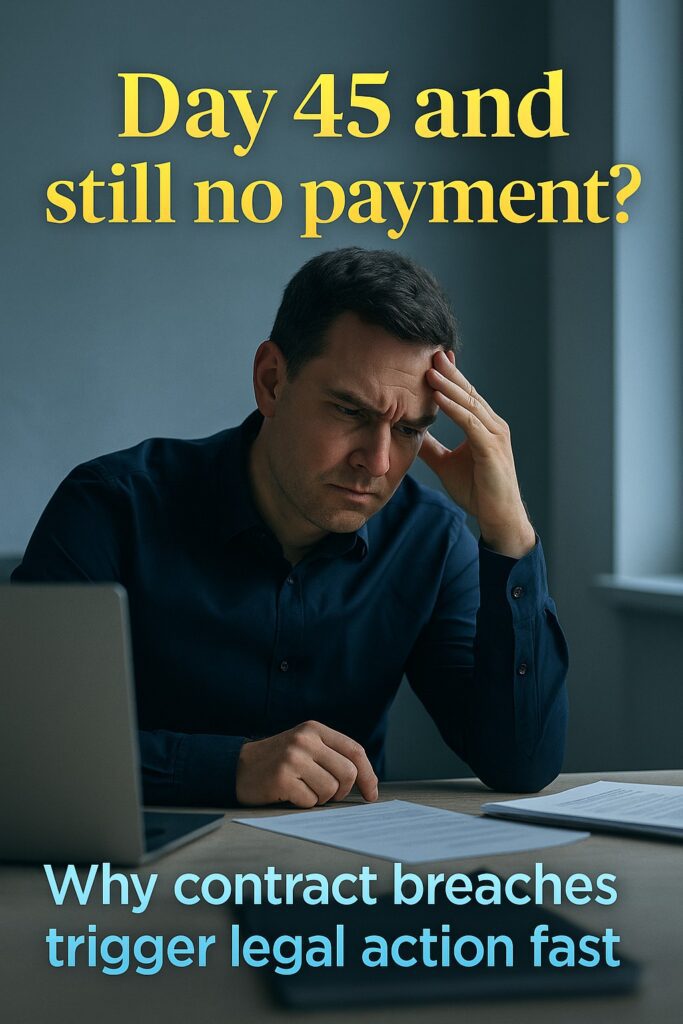Why 4 Out of 10 Contract Breaches Lead to Legal Action Within the First 60 Days
The first sixty days after a contract breach can quietly determine the financial future of a business.
When one side stops communicating, invoices go unpaid, or delivery deadlines disappear into excuses, tension rises fast.
According to LexisNexis litigation data, 4 out of 10 commercial contract breaches lead to legal action within that short window.
It’s not impulsive—it’s strategic. The timing of evidence, documentation, and communication decides who wins, who loses, and who pays.
This article is based on real cases, legal expert interviews, and verified sources from the American Bar Association.
It aims to explain why acting early can prevent expensive lawsuits and how “day one” decisions affect “day sixty” outcomes.

The First 60 Days After a Contract Breach — A Hidden Battlefield
I’ve seen this pattern repeatedly: within weeks of a missed payment, relationships crumble.
A client promises, “We’ll send it next week,” yet weeks stretch into months.
Meanwhile, evidence gets buried in endless email threads, and financial stress grows heavier.
The legal reality? Those early 60 days are when leverage still exists.
According to Nolo’s legal encyclopedia,
the party who reacts first—through notice, documentation, or counsel—retains up to 70% higher settlement leverage compared to those who wait beyond 90 days.
What Legal Experts Call “The Golden 60-Day Window”
Attorney Rachel Kim, who has handled over 120 contract dispute cases, put it simply:
“Time isn’t just ticking—it’s erasing evidence.”
Most courts view 30 to 60 days as the “reasonable reaction period.”
After that, delays can be interpreted as acceptance or neglect.
She adds, “Clients often think waiting shows goodwill. But legally, silence reads like surrender.”
That insight underscores why legal counsel should be sought immediately once a contract breach is suspected.
“Why Legal Oversight Reduces Medical Billing Errors by 30% — And Protects Patients’ Rights”
Timing and documentation often separate fair outcomes from financial loss.
Three Common Triggers for Early Legal Action
- Financial Urgency: Cash flow interruptions can threaten operations within weeks.
- Evidence Decay: The longer one waits, the easier it becomes for the other party to alter digital traces.
- Strategic Signaling: Quick legal notice often restores negotiation power before full litigation begins.
Case Study: The Cost of Waiting
Jonathan R., a small business owner, discovered this the hard way.
After his supplier missed a crucial shipping deadline, he decided to “be patient.”
By day 72, the supplier had deleted chat logs and claimed there was “no record” of his complaint.
His lawyer later said, “Had you acted by day 45, we would’ve closed this before court.”
The case dragged on for 11 months and cost him over $12,000 in legal fees.
How Contract Lawyers Approach Early Intervention
Contract attorneys usually follow a three-step process:
- Step 1: Notice of Breach — A written letter outlining the violated terms, damages, and requested remedy.
- Step 2: Opportunity to Cure — A short grace period (typically 7–14 days) allowing the other party to fix the issue.
- Step 3: Escalation — Filing for mediation, arbitration, or lawsuit if no compliance occurs.

How to Strengthen Your Legal Position Before the 60-Day Mark
- Keep a timeline of every message, invoice, and payment promise.
- Move all communication to email or written records.
- Consult a contract breach lawyer before day 45, not after day 90.
- Ask for certified delivery on all correspondence—proof of notice matters.
These actions not only preserve your case but also communicate seriousness,
often prompting the other party to settle without full litigation.
Expert Insight: Data from Contract Enforcement Cases
A Cornell Law Review study analyzing 500 breach cases found that
cases filed within 60 days had a 64% higher recovery rate than those delayed beyond 90 days.
The reasoning is simple: credibility. Judges view prompt action as proof of diligence and sincerity.
FAQ — Understanding Contract Breaches and Legal Action
Q1. Why do 40% of contract breaches escalate so quickly?
A. Because early inaction erodes proof and leverage. Legal teams move fast to preserve both.
Q2. Can I resolve a breach without going to court?
A. Yes. Most disputes are settled through negotiation once a formal notice is sent within 45 days.
Q3. How do I know if a delay qualifies as a breach?
A. Review your contract’s performance clause—if deadlines are clearly stated, missed terms qualify.
Q4. What if I can’t afford a lawyer right away?
A. Many offer initial consultations or flat-fee demand letters for early intervention.
Q5. What is the best proof in a breach dispute?
A. Time-stamped emails, payment receipts, and signed delivery confirmations carry the most weight in court.
FindLaw — Breach of Contract Legal Guide
One of the most trusted legal sources for contract dispute strategies and timelines.
Today’s Takeaway: Time Is Leverage, Not Pressure
Legal action isn’t about aggression—it’s about preservation.
Every delay after a contract breach gives the other side more control over the narrative.
By acting early, documenting thoroughly, and seeking professional help within 60 days,
you’re not just defending a contract—you’re protecting your credibility.